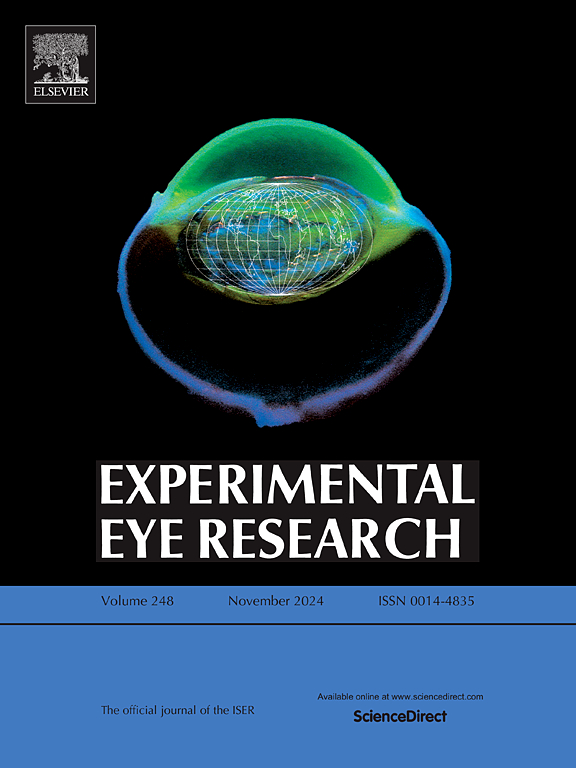The impact of break schedules on digital eye strain symptoms and ocular accommodation during prolonged near work
IF 3
2区 医学
Q1 OPHTHALMOLOGY
引用次数: 0
Abstract
This study evaluated the effects of four different break schedules on symptoms and signs of Digital Eye Strain (DES) during a 40-min reading task. Twenty-four young adults participated in four experimental conditions, performed on four different days in random order: no break, one break at 20 min, one break every 10 min and self-paced breaks. Primary outcomes included visual symptoms reported after the reading task, accommodative lag and variability during the reading task, and the near work-induced transient myopia (NITM) assessed post-task (including initial NITM and its decay). Visual symptoms were evaluated using a 10-item questionnaire, while accommodative measures were obtained with a binocular open-field autorefractor (Grand Seiko WAM-5500). Participants reported higher “eye irritation or burning” in the no-break condition compared to the 3-break (p < 0.001) and self-paced breaks conditions (p = 0.008). Eye strain was also greater in the no-break condition than in the 3-break (p = 0.04) and self-paced breaks conditions (p = 0.04). Accommodative variability showed significant effects for both break schedule (p = 0.03) and time period (p = 0.02), with greater variability observed in the no-break and 3-break conditions during the final time interval. NITM was higher in the no-break condition compared with the 3-break (p = 0.02) and self-paced breaks conditions (p = 0.02), while NITM decay was faster in the 3-break condition (p = 0.001). Accommodative lag did not differ significantly across conditions. These findings highlight the potential benefits of individualized and frequent breaks for managing DES during prolonged screen use.
休息时间对长时间近距离工作时数字眼疲劳症状和眼部调节的影响
本研究评估了四种不同的休息时间对40分钟阅读任务中数字眼疲劳(DES)症状和体征的影响。24名年轻人参加了四种实验条件,在四个不同的日子里以随机顺序进行:不休息、每20分钟休息一次、每10分钟休息一次和自定节奏休息。主要结果包括阅读任务后报告的视觉症状,阅读任务期间的适应性滞后和变异性,以及任务后评估的近工作诱发的短暂性近视(NITM)(包括初始NITM及其衰减)。使用10项调查问卷评估视觉症状,同时使用双眼开场自折射镜(Grand Seiko WAM-5500)进行调节测量。与三次休息相比,参与者在不休息条件下报告了更高的“眼睛刺激或灼烧”。0.001)和自定节奏的休息条件(p = 0.008)。不休息组的眼疲劳也大于3次休息组(p = 0.04)和自定节奏休息组(p = 0.04)。调节变异性对休息时间(p = 0.03)和休息时间(p = 0.02)都有显著影响,在最后的时间间隔中,不休息和3个休息条件下的变异性更大。不间断条件下NITM高于3次间断(p = 0.02)和自定节奏间断(p = 0.02),而3次间断条件下NITM的衰减速度更快(p = 0.001)。调节滞后在不同条件下无显著差异。这些发现强调了在长时间使用屏幕期间,个性化和频繁的休息对于管理DES的潜在益处。
本文章由计算机程序翻译,如有差异,请以英文原文为准。
求助全文
约1分钟内获得全文
求助全文
来源期刊

Experimental eye research
医学-眼科学
CiteScore
6.80
自引率
5.90%
发文量
323
审稿时长
66 days
期刊介绍:
The primary goal of Experimental Eye Research is to publish original research papers on all aspects of experimental biology of the eye and ocular tissues that seek to define the mechanisms of normal function and/or disease. Studies of ocular tissues that encompass the disciplines of cell biology, developmental biology, genetics, molecular biology, physiology, biochemistry, biophysics, immunology or microbiology are most welcomed. Manuscripts that are purely clinical or in a surgical area of ophthalmology are not appropriate for submission to Experimental Eye Research and if received will be returned without review.
 求助内容:
求助内容: 应助结果提醒方式:
应助结果提醒方式:


